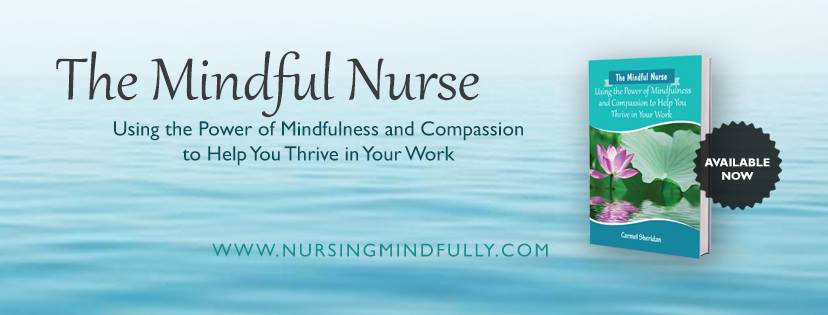by June Kaminski, RN MSN PhD(c)
Editor in Chief
I am delighted to offer this review of the new book, The Mindful Nurse – Using the Power of Mindfulness and Compassion to help you thrive in your work by Irish author, Carmel Sheridan. This book is both rich and timely: it comes to the publishing circuit at a time when many nurses are struggling with the demands of the health care system while still trying to provide high-quality, safe patient care. It also comes at a time when mindfulness is becoming socially recognized as a meaningful practice for a balanced lifestyle.
After reviewing the book, I strongly suggest that every nurse across the globe purchase a copy, and that every school of nursing make this book part of their required reading. My reasons are two fold: not only does this book help nurses provide cutting-edge, patient-centred care, but it also provides strategies for self-care and personal enrichment at the same time. Very few books offer such rich and meaningful rewards!
To introduce the author, her biography profile provides the following description:
“Carmel Sheridan is a psychotherapist, mindfulness trainer and supervisor in private practice. She is the author of The Mindful Nurse, Failure-Free Activities for the Alzheimer’s Patient, and Reminiscence: Uncovering A Lifetime of Memories. A long-time meditator, Carmel teaches mindfulness and compassion-based practices to healthcare professionals, including nurses, with a focus on self-compassion to promote resilience, focus, self-care, and well-being. She also teaches the eight-week Mindfulness-Based Stress Reduction program in workplaces, in the community, as well as online. Carmel regularly takes time out from teaching to attend retreats around the world. Contact her at carmel@nursingmindfully.com”
This 374-paged book was published by Rivertime Press (2016) and is available in paperback or ebook formats (via Kindle, compatible with all devices through their app).
The book is laid out logically in four key parts, and each part builds on the last.

PART I Embracing Mindfulness
Part one introduces the theory to show you why and how to embrace mindfulness. This first section defines what mindfulness is, how it works, and why it is important for nurses to make it a part of their professional and personal lives.
“Mindfulness is a way of being that promotes a return to the present moment, its practice cultivates awareness. It is also a self-care practice to help you avoid that slippery slope into burnout, strengthening your ability to slow down, concentrate, and pay attention to what matters most. Scientifically proven to have many health benefits, mindfulness anchors you in the present, freeing your busy mind to focus on the here and now. Although it requires persistence and patience, mindfulness is an investment well worth your time. With regular practice, you’ll see changes in your attitude toward work, your relationships, and even your lifestyle” (p. 19).
- Chapter 1: What Is Mindfulness?
- Chapter 2: Doing and Being
- Chapter 3: Everyday Mindfulness
- Chapter 4: Reaping the Benefits of Mindfulness Practice
I was impressed with the way the author used a mindfulness approach to organize the book and how she encouraged readers to adopt a mindful approach themselves as they work through the book. Nurses are supported to take their time as they move through the content: to work the exercises and reflections into their daily routines so that the practice actually does become part of their mental, emotional, physical, and spiritual itinerary. The exercises provided are also excellent tools to use with nursing students. All nurse educators constantly look for ways to help students to learn to nurse with compassion, with positive regard, and relational engagement with their clients. Mindfulness could indeed be the missing link, in this regard.
This first section also helps to set the stage for the workday with a section on mindful driving to help nurses arrive at work in a less stressful way, and mindful eating so that they reap the most benefit from breaks and return to work replenished nutritionally and psychologically.
PART II Mindfulness and the Body
Part two delves into the physiology of mindfulness and how it can benefit in managing stress, pain, preventing injuries, and providing their bodies with energy and fortitude as nurses move through their workday. Specific formal mindfulness exercises are presented, powerful techniques that actually work to help nurses to deal with the stresses and demands of work with clarity, strength, calm and a sense of serene control. Several techniques are shared in this section that can be readily applied during the workday to nourish oneself that in turn gives a nurse more energy to do their work well and truly connect with their patients without burning themself out. These techniques are also very useful for nurses who are parents. Using them in their family life could also work wonders in improving their ability to enjoy their busy lives, take time with their kids, and work on raising a resilient and compassion brood.
- Chapter 5: Mindful Self-Care
- Chapter 6: Inhabiting Your Body
- Chapter 7: Preventing Injury the Mindful Way
- Chapter 8: Coping Mindfully with Pain
- Chapter 9: Coping with Stress the Mindful Way
- Chapter 10: Mindful Movement
PART III Compassion-The Essence of Mindfulness
Caring and compassion have been the heart of nursing since the beginning of the profession. Part Three marries the notion of compassion with the art of mindfulness. Sheridan shows how compassion is integral to mindful nursing practice and gives strategies for dealing with compassion fatigue and ways to cultivate self-compassion in tandem with compassion for patients and their families and for peers.
“Recent research strongly suggests a connection between mindfulness and compassion. By fostering focus and emotional control, mindfulness not only enables greater awareness of another person’s experience but also leads to more compassionate action” (p. 173). These four chapters are invaluable tools in educating nursing students as well. It is a real challenge to mirror and cultivate compassion in students. Sheridan offers techniques that can be used in the classroom and in the clinical area to help students develop bona fide compassion and learn how to apply self-compassion as well, and protect themselves from compassion fatigue.
- Chapter 11: Understanding Compassion
- Chapter 12: The Constant Giver: Compassion Fatigue
- Chapter 13: Cultivating Self-Compassion
- Chapter 14: Strengthening Compassion
PART IV Mindfulness For Better Performance
Finally, Part Four provides several techniques for improving nursing performance in the practice setting and beyond. This section begins with an excellent chapter on how to observe and work with one’s thoughts, to recognize unhelpful thinking patterns, and what to do about them in a self-compassionate and aware way. Chapter 16 introduces valuable tips and techniques nurses can use to foster mindful teamwork.
“Synergy is the flow and harmony people experience by working in synch with one another. A well-coordinated team works better than one with members who are indifferent or at odds with each other. Undoubtedly, a group that is intelligent and dynamic enough to respond to pressure in an environment, as a unit can be more productive and efficient. An on-the-ball company of nurses is like a well-run ship or successful sports team: its sum is greater than its parts” (p. 249). Communication, preventing medication and other serious errors, and working with ward routines are all carefully presented in later chapters, in ways that can genuinely transform potentially dysfunctional workspaces.
- Chapter 15: Working with Thoughts
- Chapter 16: Mindful Teamwork
- Chapter 17: Mindful Communication
- Chapter 18: Working with Distractions, Preventing Errors
- Chapter 19: The Mindful Handover Report
- Chapter 20: The Challenge of Advancing Technology
- Chapter 21: Bringing Mindfulness and Compassion to your Healthcare Facility
This book is chock full of meaningful tools and advice that every nurse can benefit from. For example, “Set the intention to give your patient your full attention during each interaction. Unhook from the busyness of your day, come off autopilot, and take a moment to become grounded. Mindful presence does not take more time. Instead, it adds value – it makes every moment count.” This is a book worth reading and living. I encourage every nurse to add it to his or her essential library, but not to collect dust. Open it, savour it, apply it, and learn to live it! The results could be staggering if every nurse became a mindful nurse!!
SOURCE
Kaminski, J. (2016). Book Review: The Mindful Nurse. Canadian Journal of Nursing Informatics (CJNI), 11(4). Available at: http://cjni.net/journal/?p=5034






